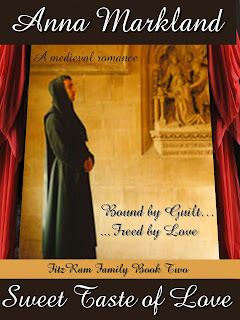The monastery of Lindisfarne was founded by Irish monk Saint Aidan, who had been sent from Iona off
the west coast of Scotland to Northumbria at
the request of King Oswald (c. AD 635).
The hero of my latest release, Sweet Taste of Love, is named Aidan.
 |
| St. Aidan |
The monastery became the base for Christian
evangelising in the North of England and also sent a successful mission to Mercia. Monks from the community of Iona
settled on the island. Northumberland's
patron saint, Saint Cuthbert, was a
monk and later Abbot of the monastery,
and his miracles and life are recorded by the
Venerable Bede. Cuthbert later became Bishop of Lindisfarne. He was
buried here, his remains later translated to Durham
Cathedral. Eadberht of Lindisfarne,
the next bishop (and Saint) was buried in the place from which Cuthbert's body
was exhumed earlier the same year when the priory was
abandoned in the late ninth century.
At some point in the early 700s the famous illuminated
manuscript known as the Lindisfarne Gospels, an
illustrated Latin copy of the Gospels of Matthew,
Mark, Luke and John, was made probably at Lindisfarne and the artist was
possibly Eadfrith, who
later became Bishop of Lindisfarne.
 |
| Cover of Lindisfarne Gospels |
Sometime in the second half of the tenth century a
monk named Aldred added an Anglo-Saxon (Old
English) gloss to the Latin text, producing the earliest surviving Old English copies of the Gospels. The Gospels were illustrated in an insular style
containing a fusion of Celtic, Germanic and Roman elements; they were probably
originally covered with a fine metal case made by a hermit called Billfrith.
In 793, a Viking raid on Lindisfarne caused much
consternation throughout the Christian west, and is now often taken as the beginning
of the Viking Age. The Anglo-Saxon Chronicle records:
In this year fierce, foreboding omens came
over the land of Northumbria. There were excessive whirlwinds, lightning
storms, and fiery dragons were seen flying in the sky. These signs
were followed by great famine, and on 8 January the ravaging of heathen men
destroyed God's church at Lindisfarne.
The more popularly accepted date for the Viking raid
on Lindisfarne is 8 June; it is believed vi id Ianr, is presumably an
error for vi id Iun (June 8) which is the date given by the Annals of Lindisfarne, when better
sailing weather would favour coastal raids.
Alcuin, a Northumbrian scholar in Charlemagne's
court at the time, wrote:
Never before has such terror appeared in Britain as we
have now suffered from a pagan race. The heathens poured out the blood of
saints around the altar, and trampled on the bodies of saints in the temple of
God, like dung in the streets.
Viking raids in 875 led to the monks fleeing the island with St Cuthbert's
bones (now buried at the Cathedral in Durham).
The bishopric was transferred to Durham in AD 1000. The heroine of Sweet Taste
of Love, Nolana Kyncade, is being escorted to a nunnery under the protection of
the Bishop of Durham when...oops! almost gave away too much!
The Lindisfarne Gospels now reside in the British Library in London, to the annoyance of some Northumbrians. The priory was re-established in Norman times in 1093 as a Benedictine house and continued until its suppression in 1536 under Henry VIII. Our hero, Aidan becomes a monk there in 1121
AD. What’s that? A monk the hero of a romance novel?
 |
| Painting of the ruins of Lindisfarne (1798) |
A causeway connects
the island to the mainland of Northumberland
and is flooded twice a day by tides, something well described by Sir Walter Scott:
For with the flow and ebb, its style
Varies from continent to isle;
Dry shod o'er sands, twice every day,
The pilgrims to the shrine find way;
Twice every day the waves efface
Of staves and sandalled feet the trace.
 |
| Lindisfarne seen from the mainland |





Interesting stuff, Anna.
ReplyDeleteGlad you enjoyed the post, Clover
DeleteVery interesting. Have you ever been to the island and can people still visit it?
ReplyDeleteMy parents took me there eons ago, but yes tourism is encouraged. Just have to wait for the tide to go out unless you go by boat.
Delete